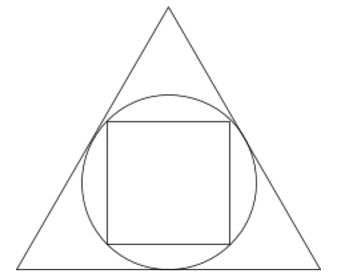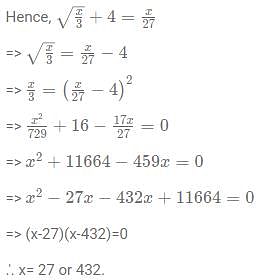CAT Mock Test- 8 (November 10) - CAT MCQ
30 Questions MCQ Test Daily Test for CAT Preparation - CAT Mock Test- 8 (November 10)
Read the passage carefully and answer the questions that follow:
The word “bias” commonly appears in conversations about mistaken judgments and unfortunate decisions. We use it when there is discrimination, for instance against women or in favor of Ivy League graduates. But the meaning of the word is broader: A bias is any predictable error that inclines your judgment in a particular direction. For instance, we speak of bias when forecasts of sales are consistently optimistic or investment decisions overly cautious.
Society has devoted a lot of attention to the problem of bias — and rightly so. But when it comes to mistaken judgments and unfortunate decisions, there is another type of error that attracts far less attention: noise. To see the difference between bias and noise, consider your bathroom scale. If on average the readings it gives are too high (or too low), the scale is biased. If it shows different readings when you step on it several times in quick succession, the scale is noisy. While bias is the average of errors, noise is their variability.
Although it is often ignored, noise is a large source of malfunction in society. In a 1981 study, for example, 208 federal judges were asked to determine the appropriate sentences for the same 16 cases. The cases were described by the characteristics of the offense (robbery or fraud, violent or not) and of the defendant (young or old, repeat or first-time offender, accomplice or principal). The average difference between the sentences that two randomly chosen judges gave for the same crime was more than 3.5 years. Considering that the mean sentence was seven years, that was a disconcerting amount of noise. Noise in real courtrooms is surely only worse, as actual cases are more complex and difficult to judge than stylized vignettes. It is hard to escape the conclusion that sentencing is in part a lottery, because the punishment can vary by many years depending on which judge is assigned to the case and on the judge’s state of mind on that day. The judicial system is unacceptably noisy.
Noise causes error, as does bias, but the two kinds of error are separate and independent. A company’s hiring decisions could be unbiased overall if some of its recruiters favor men and others favor women. However, its hiring decisions would be noisy, and the company would make many bad choices. Where does noise come from? There is much evidence that irrelevant circumstances can affect judgments. In the case of criminal sentencing, for instance, a judge’s mood, fatigue and even the weather can all have modest but detectable effects on judicial decisions. Another source of noise is that people can have different general tendencies. Judges often vary in the severity of the sentences they mete out: There are “hanging” judges and lenient ones.
A third source of noise is less intuitive, although it is usually the largest: People can have not only different general tendencies (say, whether they are harsh or lenient) but also different patterns of assessment (say, which types of cases they believe merit being harsh or lenient about). Underwriters differ in their views of what is risky, and doctors in their views of which ailments require treatment. We celebrate the uniqueness of individuals, but we tend to forget that, when we expect consistency, uniqueness becomes a liability.
Q. Which of the following statements is the author most likely to agree with?
Read the passage carefully and answer the questions that follow:
The word “bias” commonly appears in conversations about mistaken judgments and unfortunate decisions. We use it when there is discrimination, for instance against women or in favor of Ivy League graduates. But the meaning of the word is broader: A bias is any predictable error that inclines your judgment in a particular direction. For instance, we speak of bias when forecasts of sales are consistently optimistic or investment decisions overly cautious.
Society has devoted a lot of attention to the problem of bias — and rightly so. But when it comes to mistaken judgments and unfortunate decisions, there is another type of error that attracts far less attention: noise. To see the difference between bias and noise, consider your bathroom scale. If on average the readings it gives are too high (or too low), the scale is biased. If it shows different readings when you step on it several times in quick succession, the scale is noisy. While bias is the average of errors, noise is their variability.
Although it is often ignored, noise is a large source of malfunction in society. In a 1981 study, for example, 208 federal judges were asked to determine the appropriate sentences for the same 16 cases. The cases were described by the characteristics of the offense (robbery or fraud, violent or not) and of the defendant (young or old, repeat or first-time offender, accomplice or principal). The average difference between the sentences that two randomly chosen judges gave for the same crime was more than 3.5 years. Considering that the mean sentence was seven years, that was a disconcerting amount of noise. Noise in real courtrooms is surely only worse, as actual cases are more complex and difficult to judge than stylized vignettes. It is hard to escape the conclusion that sentencing is in part a lottery, because the punishment can vary by many years depending on which judge is assigned to the case and on the judge’s state of mind on that day. The judicial system is unacceptably noisy.
Noise causes error, as does bias, but the two kinds of error are separate and independent. A company’s hiring decisions could be unbiased overall if some of its recruiters favor men and others favor women. However, its hiring decisions would be noisy, and the company would make many bad choices. Where does noise come from? There is much evidence that irrelevant circumstances can affect judgments. In the case of criminal sentencing, for instance, a judge’s mood, fatigue and even the weather can all have modest but detectable effects on judicial decisions. Another source of noise is that people can have different general tendencies. Judges often vary in the severity of the sentences they mete out: There are “hanging” judges and lenient ones.
A third source of noise is less intuitive, although it is usually the largest: People can have not only different general tendencies (say, whether they are harsh or lenient) but also different patterns of assessment (say, which types of cases they believe merit being harsh or lenient about). Underwriters differ in their views of what is risky, and doctors in their views of which ailments require treatment. We celebrate the uniqueness of individuals, but we tend to forget that, when we expect consistency, uniqueness becomes a liability.
Q. Which of the following can serve as an example of 'noise' as per the the passage?
Read the passage carefully and answer the questions that follow:
The word “bias” commonly appears in conversations about mistaken judgments and unfortunate decisions. We use it when there is discrimination, for instance against women or in favor of Ivy League graduates. But the meaning of the word is broader: A bias is any predictable error that inclines your judgment in a particular direction. For instance, we speak of bias when forecasts of sales are consistently optimistic or investment decisions overly cautious.
Society has devoted a lot of attention to the problem of bias — and rightly so. But when it comes to mistaken judgments and unfortunate decisions, there is another type of error that attracts far less attention: noise. To see the difference between bias and noise, consider your bathroom scale. If on average the readings it gives are too high (or too low), the scale is biased. If it shows different readings when you step on it several times in quick succession, the scale is noisy. While bias is the average of errors, noise is their variability.
Although it is often ignored, noise is a large source of malfunction in society. In a 1981 study, for example, 208 federal judges were asked to determine the appropriate sentences for the same 16 cases. The cases were described by the characteristics of the offense (robbery or fraud, violent or not) and of the defendant (young or old, repeat or first-time offender, accomplice or principal). The average difference between the sentences that two randomly chosen judges gave for the same crime was more than 3.5 years. Considering that the mean sentence was seven years, that was a disconcerting amount of noise. Noise in real courtrooms is surely only worse, as actual cases are more complex and difficult to judge than stylized vignettes. It is hard to escape the conclusion that sentencing is in part a lottery, because the punishment can vary by many years depending on which judge is assigned to the case and on the judge’s state of mind on that day. The judicial system is unacceptably noisy.
Noise causes error, as does bias, but the two kinds of error are separate and independent. A company’s hiring decisions could be unbiased overall if some of its recruiters favor men and others favor women. However, its hiring decisions would be noisy, and the company would make many bad choices. Where does noise come from? There is much evidence that irrelevant circumstances can affect judgments. In the case of criminal sentencing, for instance, a judge’s mood, fatigue and even the weather can all have modest but detectable effects on judicial decisions. Another source of noise is that people can have different general tendencies. Judges often vary in the severity of the sentences they mete out: There are “hanging” judges and lenient ones.
A third source of noise is less intuitive, although it is usually the largest: People can have not only different general tendencies (say, whether they are harsh or lenient) but also different patterns of assessment (say, which types of cases they believe merit being harsh or lenient about). Underwriters differ in their views of what is risky, and doctors in their views of which ailments require treatment. We celebrate the uniqueness of individuals, but we tend to forget that, when we expect consistency, uniqueness becomes a liability.
Q. According to the passage, noise in a judicial system could lead to which of the following consequences?
Read the passage carefully and answer the questions that follow:
Information has never been more accessible or less reliable. So we are advised to check our sources carefully. There is so much talk of “fake news” that the term has entirely lost meaning. At school, we are taught to avoid Wikipedia, or at the very least never admit to using it in our citations. And most sources on the world wide web have been built without the standardized attributions that scaffold other forms of knowledge dissemination; they are therefore seen as degraded, even as they illuminate.
But it was only relatively recently that academic disciplines designed rigid systems for categorizing and organizing source material at all. Historian Anthony Grafton traces the genealogy of the footnote in an excellent book, which reveals many origin stories. It turns out that footnotes are related to early systems of marginalia, glosses, and annotation that existed in theology, early histories, and Medieval law. The footnote in something like its modern form seems to have been devised in the seventeenth century, and has proliferated since, with increasing standardization and rigor. And yet, Grafton writes, “appearances of uniformity are deceptive. To the inexpert, footnotes look like deep root systems, solid and fixed; to the connoisseur, however, they reveal themselves as anthills, swarming with constructive and combative activity.”
The purpose of citation, broadly speaking, is to give others credit, but it does much more than that. Famously, citations can be the sources of great enmity — a quick dismissal of a rival argument with a “cf.” They can serve a social purpose, as sly thank-yous to friends and mentors. They can perform a kind of box-checking of requisite major works. (As Grafton points out, the omission of these works can itself be a statement.) Attribution, significantly, allows others to check your work, or at least gives the illusion that they could, following a web of sources back to the origins. But perhaps above all else, citations serve a dual purpose that seems at once complementary and conflicting; they acknowledge a debt to a larger body of work while also conferring on oneself a certain kind of erudition and expertise.
Like many systems that appear meticulous, the writing of citations is a subjective art. Never more so than in fiction, where citation is an entirely other kind of animal, not required or even expected, except in the “acknowledgments” page, which is often a who’s who of the publishing world. But in the last two decades, bibliographies and sources cited pages have increasingly cropped up in the backs of novels. “It’s terribly off-putting,” James Wood said of this fad in 2006. “It would be very odd if Thomas Hardy had put at the end of all his books, ‘I’m thankful to the Dorset County Chronicle for dialect books from the 18th century.’ We expect authors to do that work, and I don’t see why we should praise them for that work.” Wood has a point, or had one — at their worst, citations in fiction are annoying, driven by an author’s anxiety to show off what he has read, to check the right boxes.
Q. Which of the following is a reason why citation is done?
Read the passage carefully and answer the questions that follow:
Information has never been more accessible or less reliable. So we are advised to check our sources carefully. There is so much talk of “fake news” that the term has entirely lost meaning. At school, we are taught to avoid Wikipedia, or at the very least never admit to using it in our citations. And most sources on the world wide web have been built without the standardized attributions that scaffold other forms of knowledge dissemination; they are therefore seen as degraded, even as they illuminate.
But it was only relatively recently that academic disciplines designed rigid systems for categorizing and organizing source material at all. Historian Anthony Grafton traces the genealogy of the footnote in an excellent book, which reveals many origin stories. It turns out that footnotes are related to early systems of marginalia, glosses, and annotation that existed in theology, early histories, and Medieval law. The footnote in something like its modern form seems to have been devised in the seventeenth century, and has proliferated since, with increasing standardization and rigor. And yet, Grafton writes, “appearances of uniformity are deceptive. To the inexpert, footnotes look like deep root systems, solid and fixed; to the connoisseur, however, they reveal themselves as anthills, swarming with constructive and combative activity.”
The purpose of citation, broadly speaking, is to give others credit, but it does much more than that. Famously, citations can be the sources of great enmity — a quick dismissal of a rival argument with a “cf.” They can serve a social purpose, as sly thank-yous to friends and mentors. They can perform a kind of box-checking of requisite major works. (As Grafton points out, the omission of these works can itself be a statement.) Attribution, significantly, allows others to check your work, or at least gives the illusion that they could, following a web of sources back to the origins. But perhaps above all else, citations serve a dual purpose that seems at once complementary and conflicting; they acknowledge a debt to a larger body of work while also conferring on oneself a certain kind of erudition and expertise.
Like many systems that appear meticulous, the writing of citations is a subjective art. Never more so than in fiction, where citation is an entirely other kind of animal, not required or even expected, except in the “acknowledgments” page, which is often a who’s who of the publishing world. But in the last two decades, bibliographies and sources cited pages have increasingly cropped up in the backs of novels. “It’s terribly off-putting,” James Wood said of this fad in 2006. “It would be very odd if Thomas Hardy had put at the end of all his books, ‘I’m thankful to the Dorset County Chronicle for dialect books from the 18th century.’ We expect authors to do that work, and I don’t see why we should praise them for that work.” Wood has a point, or had one — at their worst, citations in fiction are annoying, driven by an author’s anxiety to show off what he has read, to check the right boxes.
Q. What can be inferred about the author's stance on including citations in works of fiction from the passage?
Read the passage carefully and answer the questions that follow:
Information has never been more accessible or less reliable. So we are advised to check our sources carefully. There is so much talk of “fake news” that the term has entirely lost meaning. At school, we are taught to avoid Wikipedia, or at the very least never admit to using it in our citations. And most sources on the world wide web have been built without the standardized attributions that scaffold other forms of knowledge dissemination; they are therefore seen as degraded, even as they illuminate.
But it was only relatively recently that academic disciplines designed rigid systems for categorizing and organizing source material at all. Historian Anthony Grafton traces the genealogy of the footnote in an excellent book, which reveals many origin stories. It turns out that footnotes are related to early systems of marginalia, glosses, and annotation that existed in theology, early histories, and Medieval law. The footnote in something like its modern form seems to have been devised in the seventeenth century, and has proliferated since, with increasing standardization and rigor. And yet, Grafton writes, “appearances of uniformity are deceptive. To the inexpert, footnotes look like deep root systems, solid and fixed; to the connoisseur, however, they reveal themselves as anthills, swarming with constructive and combative activity.”
The purpose of citation, broadly speaking, is to give others credit, but it does much more than that. Famously, citations can be the sources of great enmity — a quick dismissal of a rival argument with a “cf.” They can serve a social purpose, as sly thank-yous to friends and mentors. They can perform a kind of box-checking of requisite major works. (As Grafton points out, the omission of these works can itself be a statement.) Attribution, significantly, allows others to check your work, or at least gives the illusion that they could, following a web of sources back to the origins. But perhaps above all else, citations serve a dual purpose that seems at once complementary and conflicting; they acknowledge a debt to a larger body of work while also conferring on oneself a certain kind of erudition and expertise.
Like many systems that appear meticulous, the writing of citations is a subjective art. Never more so than in fiction, where citation is an entirely other kind of animal, not required or even expected, except in the “acknowledgments” page, which is often a who’s who of the publishing world. But in the last two decades, bibliographies and sources cited pages have increasingly cropped up in the backs of novels. “It’s terribly off-putting,” James Wood said of this fad in 2006. “It would be very odd if Thomas Hardy had put at the end of all his books, ‘I’m thankful to the Dorset County Chronicle for dialect books from the 18th century.’ We expect authors to do that work, and I don’t see why we should praise them for that work.” Wood has a point, or had one — at their worst, citations in fiction are annoying, driven by an author’s anxiety to show off what he has read, to check the right boxes.
Q. "Citations serve a dual purpose that seems at once complementary and conflicting." Which of the following best captures the reason why the author makes this statement?
Read the passage carefully and answer the questions that follow:
Humiliation is more than an individual and subjective feeling. It is an instrument of political power, wielded with intent. In the late 1930s, Soviet show trials used every means to degrade anyone whom Stalin considered a potentially dangerous opponent. National Socialism copied this practice whenever it put ‘enemies of the people’ on trial. On the streets of Vienna in 1938, officials forced Jews to kneel on the pavement and scrub off anti-Nazi graffiti to the laughter of non-Jewish men, women and children. During the Cultural Revolution in China, young activists went out of their way to relentlessly humiliate senior functionaries - a common practice that, to this day, hasn’t been officially reprimanded or rectified.
Liberal democracies, especially after the Second World War, have taken issue with these practices. We like to believe that we have largely eradicated such politics from our societies. Compared with totalitarian regimes of the 20th century, this belief might seem justified. Yet we’re still a far cry from being ‘decent societies’ whose members and institutions, in the philosopher Avishai Margalit’s terms, ‘do not humiliate people’, but respect their dignity. Although construction of the road to decency began as early as around 1800, it was - and remains - paved with obstacles and exceptions.
Mass opposition to the politics of humiliation began from the early 19th century in Europe, as lower-class people increasingly objected to disrespectful treatment. Servants, journeymen and factory workers alike used the language of honour and concepts of personal and social self-worth - previously monopolised by the nobility and upper-middle classes - to demand that they not be verbally and physically insulted by employers and overseers.
This social change was enabled and supported by a new type of honour that followed the invention of ‘citizens’ (rather than subjects) in democratising societies. Citizens who carried political rights and duties were also seen as possessing civic honour. Traditionally, social honour had been stratified according to status and rank, but now civic honour pertained to each and every citizen, and this helped to raise their self-esteem and self-consciousness. Consequently, humiliation, and other demonstrations of the alleged inferiority of others, was no longer considered a legitimate means by which to exert power over one’s fellow citizens.
Historically then, humiliation could be felt - and objected to - only once the notion of equal citizenship and human dignity entered political discourse and practice. As long as society subscribed to the notion that some individuals are fundamentally superior to others, people had a hard time feeling humiliated. They might feel treated unfairly, and rebel. But they wouldn’t perceive such treatment as humiliating, per se. Humiliation can be experienced only when the victims consider themselves on a par with the perpetrator - not in terms of actual power, but in terms of rights and dignity. This explains the surge of libel suits in Europe during the 19th century: they reflected the democratised sense of honour in societies that had granted and institutionalised equal rights after the French Revolution (even in countries that didn’t have a revolution).
The evolution of the legal system in Western nations serves as both a gauge of, and an active participant in, these developments. From the Middle Ages to the early 19th century, public shaming was used widely as a supplementary punishment for men and women sentenced for unlawful acts.
Q. Which of the following is true based on the passage?
Read the passage carefully and answer the questions that follow:
Humiliation is more than an individual and subjective feeling. It is an instrument of political power, wielded with intent. In the late 1930s, Soviet show trials used every means to degrade anyone whom Stalin considered a potentially dangerous opponent. National Socialism copied this practice whenever it put ‘enemies of the people’ on trial. On the streets of Vienna in 1938, officials forced Jews to kneel on the pavement and scrub off anti-Nazi graffiti to the laughter of non-Jewish men, women and children. During the Cultural Revolution in China, young activists went out of their way to relentlessly humiliate senior functionaries - a common practice that, to this day, hasn’t been officially reprimanded or rectified.
Liberal democracies, especially after the Second World War, have taken issue with these practices. We like to believe that we have largely eradicated such politics from our societies. Compared with totalitarian regimes of the 20th century, this belief might seem justified. Yet we’re still a far cry from being ‘decent societies’ whose members and institutions, in the philosopher Avishai Margalit’s terms, ‘do not humiliate people’, but respect their dignity. Although construction of the road to decency began as early as around 1800, it was - and remains - paved with obstacles and exceptions.
Mass opposition to the politics of humiliation began from the early 19th century in Europe, as lower-class people increasingly objected to disrespectful treatment. Servants, journeymen and factory workers alike used the language of honour and concepts of personal and social self-worth - previously monopolised by the nobility and upper-middle classes - to demand that they not be verbally and physically insulted by employers and overseers.
This social change was enabled and supported by a new type of honour that followed the invention of ‘citizens’ (rather than subjects) in democratising societies. Citizens who carried political rights and duties were also seen as possessing civic honour. Traditionally, social honour had been stratified according to status and rank, but now civic honour pertained to each and every citizen, and this helped to raise their self-esteem and self-consciousness. Consequently, humiliation, and other demonstrations of the alleged inferiority of others, was no longer considered a legitimate means by which to exert power over one’s fellow citizens.
Historically then, humiliation could be felt - and objected to - only once the notion of equal citizenship and human dignity entered political discourse and practice. As long as society subscribed to the notion that some individuals are fundamentally superior to others, people had a hard time feeling humiliated. They might feel treated unfairly, and rebel. But they wouldn’t perceive such treatment as humiliating, per se. Humiliation can be experienced only when the victims consider themselves on a par with the perpetrator - not in terms of actual power, but in terms of rights and dignity. This explains the surge of libel suits in Europe during the 19th century: they reflected the democratised sense of honour in societies that had granted and institutionalised equal rights after the French Revolution (even in countries that didn’t have a revolution).
The evolution of the legal system in Western nations serves as both a gauge of, and an active participant in, these developments. From the Middle Ages to the early 19th century, public shaming was used widely as a supplementary punishment for men and women sentenced for unlawful acts.
Q. Which of the following topics would be a likely continuation of the given discussion?
The four sentences (labelled 1, 2, 3, 4) below, when properly sequenced, would yield a coherent paragraph. Decide on the proper sequencing of the order of the sentences and key in the sequence of the four numbers as your answer:
- These observations are informative but do not address fundamental questions about how social-cognitive brain systems develop or why their development might be different for autistic people.
- Accordingly, differences in the development and/or transmissions of information across this distributed social-cognitive brain network may contribute to differences in mentalizing among autistic people.
- Social-cognitive neuroscience tells us that brain systems of the medial frontal cortex, temporal cortex and parietal cortex, as well as reward centres of the brain, enable mentalizing.
- These differences can lead to a range of outcomes, from problems in the capacity to mentalize to alterations in the spontaneous use of mentalizing or the motivation and effort involved in mentalizing during social interactions.
The four sentences (labelled 1, 2, 3, 4) below, when properly sequenced, would yield a coherent paragraph. Decide on the proper sequencing of the order of the sentences and key in the sequence of the four numbers as your answer:
- As a matter of fact, many of the tools and resources that I used on my missions, such as solar panels and rechargeable storage batteries, are also the answer to our problems here on Earth.
- After seeing the Earth dramatically change from this unique perspective, I firmly believe that solving climate change is the moonshot of the 21st century.
- On my last mission in 2016, only 17 years later, burning and clear-cutting were clearly evident in the region.
- During my first mission, in 1999, to fix the Hubble Space Telescope, I remember passing over South America and being awed by the sheer size of the Amazon rainforest.
The passage given below is followed by four alternate summaries. Choose the option that best captures the essence of the passage.
Fossil fuel divestment, a growing movement, urges organizations to withdraw investment from companies involved in extracting fossil fuels. This movement aims to reduce carbon emissions to combat climate change and is a powerful tool for social change. Critics argue that divestment alone won't stop climate change and that it might harm investors’ returns. Proponents, however, see it as a moral and pragmatic stand, forcing the industry to reckon with its role in climate change while paving the way for investment in sustainable energy alternatives.
Totalitarianism is not always operated by diktat. It can be insinuated by suggestion and replication. Dissent does not have to be banned if it is countered by orchestrated mass promo rallies and hypnotizing oratory. Despotic establishments do not need to turn Hitlerian; all they need to do is to let the Reich chemistry work. Self-regulation and self-censorship will click in. Then any dissident who wants to retain his intellectual liberty will find himself thwarted by the general drift of society rather than by active persecution.
Directions: Read the following information and answer the question below.
There is a square shaped board similar to chessboard which is having eight rows and eight columns. On this board, rows are numbered 1 to 8 (bottom to top) and the columns are labelled a to h (left to right). On the chessboard, the King is placed at e1. The position of a piece is given by the combination of column and row labels. For example, position e4 means that the piece is in the eth column and the 4th row. In the chessboard, Rook placed anywhere can attack another piece if the piece is present in the same row, or in the same column in any possible 4 directions, provided there is no other piece in the path from the Rook to that piece.
Q. Find the minimum number of positions which the Rook can possibly attack irrespective of the placement of other pieces.
Directions: Read the information given below and answer the question:
Exactly five friends – Connor, Richard, Poppy, Mason and Sarah – were playing a racing game which consists of four levels. In each level, the persons who stood first, second and third were awarded points of 10, 7.5 and 5 respectively, while the other two persons were awarded 2.5 points each.
It is also known that
(1) the total points earned by no two friends in the game were same.
(2) Connor earned 5 more points than Poppy and neither of them earned the highest total points in the game.
(3) Richard, who was last in one of the four levels, earned a total of 22.5 points in the game but he was not first in any level.
(4) one of the five persons was first in more than one level and he did not win the highest points in the game.
(5) Mason was not third in any of the four levels but was first in one of the four levels.
(6) the points that Poppy earned in the game were more than the points that Sarah earned.
Q. Who can earned higher points than Sarah in at least three of the four levels? Key in the value.
Directions: Read the information given below and answer the question:
Exactly five friends – Connor, Richard, Poppy, Mason and Sarah – were playing a racing game which consists of four levels. In each level, the persons who stood first, second and third were awarded points of 10, 7.5 and 5 respectively, while the other two persons were awarded 2.5 points each.
It is also known that
(1) the total points earned by no two friends in the game were same.
(2) Connor earned 5 more points than Poppy and neither of them earned the highest total points in the game.
(3) Richard, who was last in one of the four levels, earned a total of 22.5 points in the game but he was not first in any level.
(4) one of the five persons was first in more than one level and he did not win the highest points in the game.
(5) Mason was not third in any of the four levels but was first in one of the four levels.
(6) the points that Poppy earned in the game were more than the points that Sarah earned.
Q. How many of the friends stood first in any of the levels?
Directions: Study the given information and answer the following question.
On a particular day, exactly twelve aircraft visited a certain airport and each aircraft availed of exactly one type of maintenance at the airport. Of the twelve aircraft, four needed preventive maintenance, four needed corrective maintenance and four needed predictive maintenance. The twelve aircraft landed at the airport at the same time and each aircraft took off immediately after it had availed respective maintenance schedule. At the airport, each of the three types of maintenance was provided in different hangars - Hangar-1 for preventive maintenance, Hangar-2 for corrective maintenance and Hangar-3 for predictive maintenance. Each hangar can hold only one aircraft at any time. The time taken by Hangar-1, Hangar-2 and Hangar-3 to maintain and repair one aircraft is from 11 hours to 15 hours (both inclusive), from 16 hours to 20 hours (both inclusive), and from 21 hours to 25 hours (both inclusive), respectively.
Engineers in hangars always start servicing an aircraft waiting to avail of their maintenance schedule without delay, unless they are already servicing another aircraft. The time spent by any aircraft at the airport is the sum of the time spent by it waiting to be maintained and the time spent by the corresponding engineers in hangars in servicing it.
Given below is the total time spent by each of the twelve aircraft at the airport (in alphabetical order of their names).
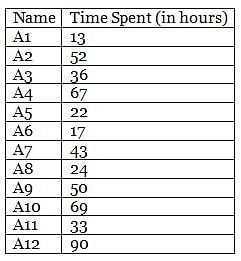
Q. Which of the following aircraft was maintained in Hangar-2?
Directions: Study the given information and answer the following question.
On a particular day, exactly twelve aircraft visited a certain airport and each aircraft availed of exactly one type of maintenance at the airport. Of the twelve aircraft, four needed preventive maintenance, four needed corrective maintenance and four needed predictive maintenance. The twelve aircraft landed at the airport at the same time and each aircraft took off immediately after it had availed respective maintenance schedule. At the airport, each of the three types of maintenance was provided in different hangars - Hangar-1 for preventive maintenance, Hangar-2 for corrective maintenance and Hangar-3 for predictive maintenance. Each hangar can hold only one aircraft at any time. The time taken by Hangar-1, Hangar-2 and Hangar-3 to maintain and repair one aircraft is from 11 hours to 15 hours (both inclusive), from 16 hours to 20 hours (both inclusive), and from 21 hours to 25 hours (both inclusive), respectively.
Engineers in hangars always start servicing an aircraft waiting to avail of their maintenance schedule without delay, unless they are already servicing another aircraft. The time spent by any aircraft at the airport is the sum of the time spent by it waiting to be maintained and the time spent by the corresponding engineers in hangars in servicing it.
Given below is the total time spent by each of the twelve aircraft at the airport (in alphabetical order of their names).
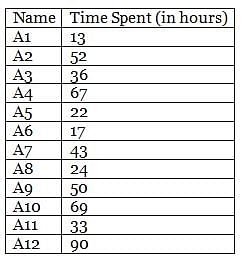
Q. Which of the following aircraft was not maintained in Hangar-1?
Directions: Study the given information and answer the following question.
On a particular day, exactly twelve aircraft visited a certain airport and each aircraft availed of exactly one type of maintenance at the airport. Of the twelve aircraft, four needed preventive maintenance, four needed corrective maintenance and four needed predictive maintenance. The twelve aircraft landed at the airport at the same time and each aircraft took off immediately after it had availed respective maintenance schedule. At the airport, each of the three types of maintenance was provided in different hangars - Hangar-1 for preventive maintenance, Hangar-2 for corrective maintenance and Hangar-3 for predictive maintenance. Each hangar can hold only one aircraft at any time. The time taken by Hangar-1, Hangar-2 and Hangar-3 to maintain and repair one aircraft is from 11 hours to 15 hours (both inclusive), from 16 hours to 20 hours (both inclusive), and from 21 hours to 25 hours (both inclusive), respectively.
Engineers in hangars always start servicing an aircraft waiting to avail of their maintenance schedule without delay, unless they are already servicing another aircraft. The time spent by any aircraft at the airport is the sum of the time spent by it waiting to be maintained and the time spent by the corresponding engineers in hangars in servicing it.
Given below is the total time spent by each of the twelve aircraft at the airport (in alphabetical order of their names).
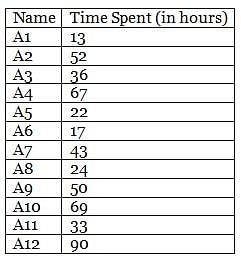
Q. For what more time was Hangar-3 busier than Hangar-1? Key in the value in hours.
Directions: Read the following passage carefully and answer the following question.
A survey was conducted by EPFO to find out the number of people working in three different sectors, viz. banking, education and transport, across three metro cities of India - Mumbai, Delhi and Kolkata. The table below represents the collected sector-wise data:

The survey results were also divided into two groups on the basis of whether the people are working in the government sector (G) or the private sector (P).
It is also known that:
1. The total number of people surveyed in Delhi was equal to the total number of people surveyed in Kolkata, which was 1500 less than the number of people surveyed in Mumbai.
2. The ratio of the number of people working in G and the number of people working in P was 10 : 7, respectively.
3. In transport sector, the number of people working in G was equal to the number of people working in P.
4. In G, the number of people working in the education sector in Mumbai was equal to the number of people working in the transport sector in Kolkata.
5. In G, the number of people working in the education sector in Kolkata was twice that of the number of people in the banking sector in Kolkata.
6. In P, the total number of people working in the education sector was 8500.
7. In P, the ratio of the number people working in the transport sector in Mumbai, Delhi and Kolkata was 12 : 11 : 4, respectively.
8. In G, the ratio of the number of people working in banking sector from Mumbai and Kolkata was 10 : 7, respectively.
9. In P, the number of people working in the banking sector in Delhi was 2500.
10. In G, the number of people working in the education sector was 25% greater than the number of people working in the banking sector.
Q. What was the respective ratio of the number of people working in the education sector in Mumbai, Kolkata and Delhi in P?
Directions: Read the following passage carefully and answer the following question.
A survey was conducted by EPFO to find out the number of people working in three different sectors, viz. banking, education and transport, across three metro cities of India - Mumbai, Delhi and Kolkata. The table below represents the collected sector-wise data:

The survey results were also divided into two groups on the basis of whether the people are working in the government sector (G) or the private sector (P).
It is also known that:
1. The total number of people surveyed in Delhi was equal to the total number of people surveyed in Kolkata, which was 1500 less than the number of people surveyed in Mumbai.
2. The ratio of the number of people working in G and the number of people working in P was 10 : 7, respectively.
3. In transport sector, the number of people working in G was equal to the number of people working in P.
4. In G, the number of people working in the education sector in Mumbai was equal to the number of people working in the transport sector in Kolkata.
5. In G, the number of people working in the education sector in Kolkata was twice that of the number of people in the banking sector in Kolkata.
6. In P, the total number of people working in the education sector was 8500.
7. In P, the ratio of the number people working in the transport sector in Mumbai, Delhi and Kolkata was 12 : 11 : 4, respectively.
8. In G, the ratio of the number of people working in banking sector from Mumbai and Kolkata was 10 : 7, respectively.
9. In P, the number of people working in the banking sector in Delhi was 2500.
10. In G, the number of people working in the education sector was 25% greater than the number of people working in the banking sector.
Q. In which of the following sectors was the number of people working in the government sector at least 50% more than that working in the private sector?
Find the sum of integer values of x (|x| <10) satisfying the following inequality:

A right angled triangle has an inradius of length 3 cm and a circumradius of length 12.5 cm. What is the area of the triangle in square cms?
Find the area of the square inscribed inside a circle, which is in turn is inscribed inside an equilateral triangle of side 3√3 cm.
Find the range of values of x satisfying the following inequation:

Find the value of [log2 100]+[log3 99]+[log4 98]+[log5 97]+....+[log100 2] where [X] equals the largest integer less than or equal to X.
In a biased dice with numbers from 1 to 6, each prime number has an equal chance of showing up and each non-prime number has an equal chance of showing up on a roll of the dice. If the probability that an odd number is rolled is 4/9, what is the probability that 6 is rolled in ane throw of the dice?
Out of a certain number of students in the college, square root of one-third the total students were selected to represent in a sports tournament. 4 more students were selected as extras for the squad. The remaining 26/27 of the total students failed to be selected for the tournament. How many students did the college have in total?
A milk seller buys milk at Rs 50/L and then mixes some water into it, after which he marks up the price of the solution by 20% and gives a discount of 20% on the marked price. If he earns a profit of 20% in the entire transaction, what is the amount of water(in mL) mixed for every 2L of pure milk? Assume that the cost of water is negligible.
How many terms are common in the following series?
S1 = 9, 18, 27, 36, 45, ....... (up to 1000 terms)
S2 = 16, 27, 38, 49, 60, 71, ....... (up to 1000 terms)
|
152 docs|327 tests
|



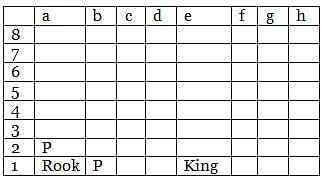
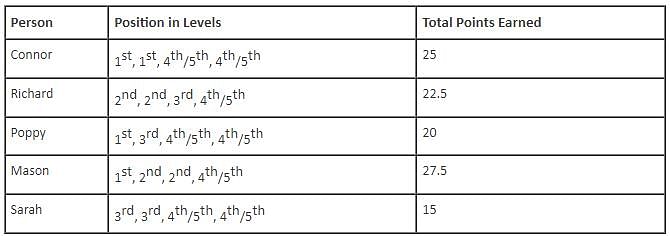
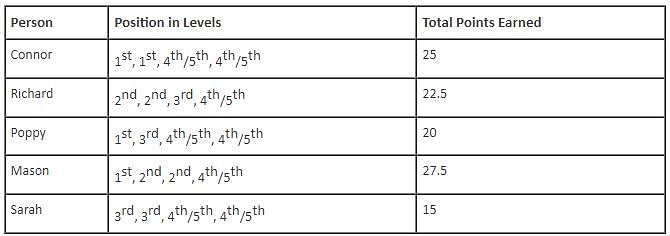










 where a and b are the perpendicular sides of the right angled triangle.
where a and b are the perpendicular sides of the right angled triangle.
